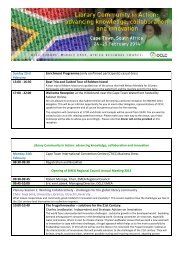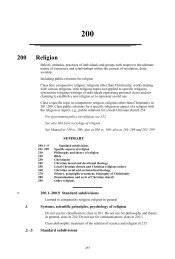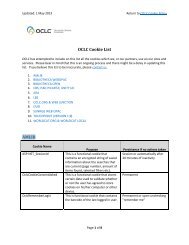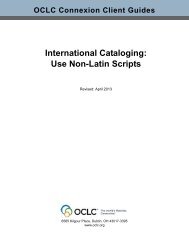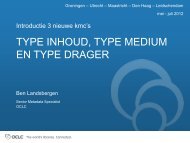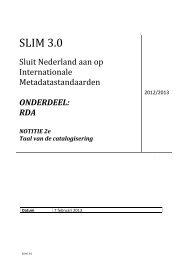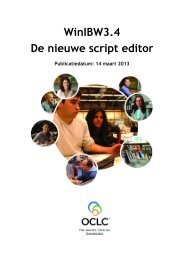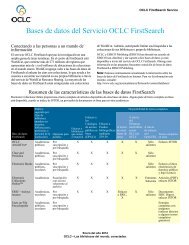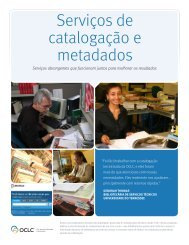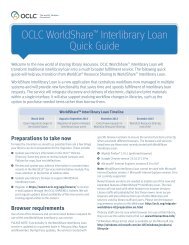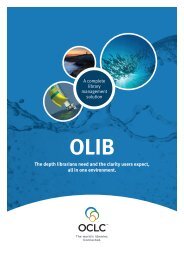Vertalen van RDA richtlijnen in het Nederlands - OCLC
Vertalen van RDA richtlijnen in het Nederlands - OCLC
Vertalen van RDA richtlijnen in het Nederlands - OCLC
You also want an ePaper? Increase the reach of your titles
YUMPU automatically turns print PDFs into web optimized ePapers that Google loves.
SLIM 3.0<br />
Sluit Nederland aan op<br />
Internationale<br />
Metadatastandaarden<br />
ONDERDEEL:<br />
<strong>RDA</strong><br />
NOTITIE 2a<br />
<strong>Vertalen</strong> <strong>van</strong> <strong>RDA</strong> <strong>richtlijnen</strong><br />
<strong>in</strong> <strong>het</strong> <strong>Nederlands</strong><br />
Datum 10 december 2012<br />
2012
Documentgeschiedenis<br />
09 november 2012: 1 e versie<br />
21 november 2012: Besproken <strong>in</strong> projectgroep op 19 november, 2 e versie<br />
28 november 2012: Commentaar Joke Webb<strong>in</strong>k verwerkt, 3 e versie.<br />
29 november 2012: Commentaar projectgroep verwerkt, 4 e versie<br />
10 december 2012: Commentaar projectgroep verwerkt, 5 e versie<br />
SLIM 3.0<br />
2
Inhoudsopgave<br />
1. INLEIDING 4<br />
2. UITGANGSPUNTEN 4<br />
3. ARGUMENTEN VOOR EN TEGEN VERTALING 4<br />
3.1. Argumenten voor vertal<strong>in</strong>g <strong>in</strong> <strong>het</strong> <strong>Nederlands</strong> .................................................................................................... 4<br />
3.2. Argumenten tegen vertal<strong>in</strong>g <strong>in</strong> <strong>het</strong> <strong>Nederlands</strong> ................................................................................................... 4<br />
4. VOORSTEL 5<br />
BIJLAGE 1. GLOSSARY 6<br />
SLIM 3.0<br />
3
1. Inleid<strong>in</strong>g<br />
Deze notitie is een nadere uitwerk<strong>in</strong>g <strong>van</strong> een voorstel uit <strong>het</strong> advies <strong>van</strong> de <strong>RDA</strong> Werkgroep<br />
<strong>van</strong> 28 februari 2011 betreffende de vertal<strong>in</strong>g <strong>van</strong> de <strong>RDA</strong> <strong>richtlijnen</strong> <strong>in</strong> <strong>het</strong> <strong>Nederlands</strong>. Het<br />
uitgangspunt is daarbij de volgende tekst <strong>in</strong> <strong>het</strong> Programmaplan SLIM 3.0 (15 mei 2012), Bijlage 2,<br />
Aandachtspunten voor Project 2 <strong>RDA</strong>, punt 3:<br />
“Vaststellen <strong>in</strong> hoeverre een vertal<strong>in</strong>g nodig is en <strong>in</strong>dien op onderdelen een vertal<strong>in</strong>g gewenst<br />
is, voorstellen voor de realisatie er<strong>van</strong> te ontwikkelen”.<br />
2. Uitgangspunten<br />
Het onderzoek <strong>van</strong> de <strong>RDA</strong> Werkgroep of de <strong>RDA</strong> catalogiseerregels al dan niet vertaald<br />
moeten worden <strong>in</strong> <strong>het</strong> <strong>Nederlands</strong>, houdt verband met <strong>het</strong> realiseren <strong>van</strong> een optimale<br />
toegankelijkheid <strong>van</strong> de <strong>RDA</strong> catalogiseerregels voor alle titelbeschrijvers <strong>in</strong> Nederland. Dit<br />
ongeacht hun kennis <strong>van</strong> <strong>het</strong> Engels en ongeacht hun kennis <strong>van</strong> de Engelse term<strong>in</strong>ologie. Doel<br />
<strong>van</strong> een vertal<strong>in</strong>g zou zijn de beschrijv<strong>in</strong>g en de verwerk<strong>in</strong>g <strong>van</strong> documenten te<br />
vergemakkelijken, te stroomlijnen en te optimaliseren.<br />
De <strong>RDA</strong> Werkgroep signaleert de behoefte aan een vertal<strong>in</strong>g <strong>van</strong> <strong>RDA</strong> <strong>in</strong> <strong>het</strong> <strong>Nederlands</strong>. De<br />
<strong>RDA</strong> Werkgroep heeft zich tot taak gesteld om te bepalen of <strong>het</strong> <strong>in</strong>derdaad z<strong>in</strong>vol is om de <strong>RDA</strong><br />
catalogiseerregels <strong>in</strong> <strong>het</strong> <strong>Nederlands</strong> te vertalen. En of dit praktisch en f<strong>in</strong>ancieel haalbaar is. Dit<br />
is bepaald aan de hand <strong>van</strong> een aantal argumenten vóór en tegen vertal<strong>in</strong>g.<br />
3. Argumenten voor en tegen vertal<strong>in</strong>g<br />
3.1. Argumenten voor vertal<strong>in</strong>g <strong>in</strong> <strong>het</strong> <strong>Nederlands</strong><br />
Het is prettig om kennis te nemen <strong>van</strong> de nieuwe regels <strong>in</strong> <strong>het</strong> <strong>Nederlands</strong> als moedertaal.<br />
De Onl<strong>in</strong>e Richtlijnen voor <strong>het</strong> catalogiseren <strong>in</strong> <strong>het</strong> GGC zijn <strong>in</strong> <strong>het</strong> <strong>Nederlands</strong> en functioneren al<br />
jaren goed.<br />
In situaties waar<strong>in</strong> er <strong>in</strong> de <strong>RDA</strong> catalogiseerregels sprake is <strong>van</strong> moeilijk te begrijpen Engels is <strong>het</strong><br />
handig om een vertal<strong>in</strong>g en toelicht<strong>in</strong>g <strong>in</strong> <strong>het</strong> <strong>Nederlands</strong> te hebben. Dus wel vertalen, maar alleen<br />
daar waar <strong>het</strong> nodig is.<br />
niet alle medewerkers beschikken over een kennisniveau <strong>van</strong> <strong>het</strong> Engels dat nodig is om de <strong>RDA</strong><br />
Richtlijnen te begrijpen.<br />
3.2. Argumenten tegen vertal<strong>in</strong>g <strong>in</strong> <strong>het</strong> <strong>Nederlands</strong><br />
De <strong>RDA</strong> catalogiseerregels zijn geschreven <strong>in</strong> <strong>het</strong> Engels als een <strong>in</strong>ternationale vaktaal.<br />
Catalogiseerders moeten primair werken met de <strong>RDA</strong> catalogiseerregels uit de <strong>RDA</strong> Toolkit, die<br />
geheel <strong>in</strong> de Engelse taal is. Professionele beschrijvers worden geacht de vakliteratuur <strong>in</strong> <strong>het</strong> Engels<br />
te kunnen lezen en te begrijpen. Zeker nu de hertal<strong>in</strong>g <strong>van</strong> de <strong>RDA</strong> catalogiseerregels die tijdens de<br />
test zijn gebruikt zijn voltooi<strong>in</strong>g nadert. Deze hertal<strong>in</strong>g door Chris Oliver, de Jo<strong>in</strong>t Steer<strong>in</strong>g<br />
Committee en <strong>het</strong> US <strong>RDA</strong> Test Committee zal de leesbaarheid <strong>van</strong> de Engelse tekst zeker verhogen.<br />
Het is de bedoel<strong>in</strong>g dat dit project <strong>in</strong> april 2013 afgesloten wordt en dat de tekst <strong>in</strong> juni 2013 <strong>in</strong> druk<br />
zal verschijnen.<br />
De doelgroep voor de vertal<strong>in</strong>g <strong>in</strong> <strong>het</strong> <strong>Nederlands</strong> is beperkt wat betreft <strong>het</strong> aantal catalogiseerders<br />
en de om<strong>van</strong>g <strong>van</strong> <strong>het</strong> <strong>Nederlands</strong>e taalgebied. De al bestaande vertal<strong>in</strong>g <strong>in</strong> <strong>het</strong> Duits en Frans <strong>van</strong><br />
de <strong>RDA</strong> catalogiseerregels is gerechtvaardigd omdat <strong>in</strong> dat taalgebied de doelgroep veel groter is,<br />
evenals <strong>het</strong> aantal catalogiseerders dat opgeleid moet worden. In Nederland bestaat er mogelijk<br />
SLIM 3.0<br />
4
alleen bij de Openbare Bibliotheken en kle<strong>in</strong>ere speciale bibliotheken behoefte aan een vertal<strong>in</strong>g<br />
<strong>van</strong> de nieuwe regels <strong>in</strong> <strong>het</strong> <strong>Nederlands</strong>.<br />
Het vertalen <strong>van</strong> de gehele tekst <strong>van</strong> de <strong>RDA</strong> catalogiseerregels is zeer arbeids<strong>in</strong>tensief en vraagt<br />
veel tijd en f<strong>in</strong>anciële middelen. Bovendien kan er geen <strong>in</strong>schatt<strong>in</strong>g gemaakt worden of de vertal<strong>in</strong>g<br />
<strong>in</strong> <strong>het</strong> <strong>Nederlands</strong> dusdanig frequent en <strong>in</strong> breed verband gebruikt zal worden, dat een vertal<strong>in</strong>g<br />
gerechtvaardigd en economisch verantwoord is.<br />
Het vertalen <strong>van</strong> de nieuwe catalogiseerregels is nog maar <strong>het</strong> beg<strong>in</strong>, want er komen cont<strong>in</strong>ue<br />
updates op de regels. De wijzig<strong>in</strong>gen <strong>in</strong> de regels en de formuler<strong>in</strong>g daar<strong>van</strong> zullen elkaar <strong>in</strong> de<br />
komende jaren snel opvolgen. Wie gaat al deze wijzig<strong>in</strong>gen en aanvull<strong>in</strong>gen bijhouden en vertalen?<br />
In Nederland hebben catalogiseerders een vaktaal die gerelateerd is aan de FOBID-regels. De oude<br />
termen hebben een bepaalde lad<strong>in</strong>g. In <strong>RDA</strong> krijgt een term die bekend is uit de FOBID-regels soms<br />
een nieuwe betekenis.<br />
Het tegelijkertijd en door elkaar gebruiken <strong>van</strong> een Engelse vakterm en de vertal<strong>in</strong>g er<strong>van</strong> <strong>in</strong> <strong>het</strong><br />
<strong>Nederlands</strong> is niet aan te bevelen, want dit schept verwarr<strong>in</strong>g bij de catalogiseerder die bijvoorbeeld<br />
met de Toolkit moet werken.<br />
Een aantal termen is moeilijk <strong>in</strong> <strong>het</strong> <strong>Nederlands</strong> te vertalen. Soms vraagt <strong>het</strong> <strong>Nederlands</strong> een<br />
omschrijv<strong>in</strong>g waar <strong>in</strong> <strong>het</strong> Engels een enkel woord voldoende is. In andere gevallen levert de vertal<strong>in</strong>g<br />
<strong>in</strong> <strong>het</strong> <strong>Nederlands</strong> ook geen “mooie” of eenduidige vakterm op. Dit komt de duidelijkheid niet ten<br />
goede. Bovendien schept een vertal<strong>in</strong>g uit <strong>het</strong> Engels <strong>in</strong> bepaalde gevallen verwarr<strong>in</strong>g omdat <strong>het</strong><br />
Engelse woord twee of meer betekenissen kan hebben, die afhankelijk zijn <strong>van</strong> de context waar<strong>in</strong><br />
<strong>het</strong> woord wordt gebruikt.<br />
4. Voorstel<br />
De <strong>RDA</strong> projectgroep acht <strong>het</strong> niet haalbaar om <strong>RDA</strong> <strong>in</strong>tegraal <strong>van</strong>uit <strong>het</strong> Engels <strong>in</strong> <strong>het</strong><br />
<strong>Nederlands</strong> te vertalen, maar v<strong>in</strong>dt <strong>het</strong> wel verstandig dat bepaalde algemene documentatie<br />
over <strong>RDA</strong> <strong>in</strong> <strong>het</strong> <strong>Nederlands</strong> beschikbaar komt. Met name <strong>het</strong> Engelstalige glossarium <strong>van</strong> <strong>RDA</strong><br />
moet zeker voorzien worden <strong>van</strong> een vertal<strong>in</strong>g dan wel toelicht<strong>in</strong>g <strong>in</strong> <strong>het</strong> <strong>Nederlands</strong>, omdat dit<br />
de doorzoekbaarheid <strong>van</strong> de <strong>RDA</strong> Toolkit vergemakkelijkt. Het belangrijkste is dat<br />
catalogiseerders de term<strong>in</strong>ologie die door <strong>RDA</strong> gebruikt wordt volledig begrijpen, zodat er geen<br />
misverstanden kunnen ontstaan over wat er bedoeld wordt. Daarbij helpt een <strong>in</strong> <strong>het</strong><br />
<strong>Nederlands</strong> gestelde vertal<strong>in</strong>g.<br />
De <strong>RDA</strong> Projectgroep stelt voor om daarbij prioriteit te geven aan de vertal<strong>in</strong>g <strong>in</strong> <strong>het</strong><br />
<strong>Nederlands</strong> <strong>van</strong> de glossary <strong>in</strong> de Statement of International Catalogu<strong>in</strong>g Pr<strong>in</strong>ciples (ICP 2009),<br />
die de basis vormt <strong>van</strong> de <strong>in</strong> <strong>RDA</strong> gebruikte term<strong>in</strong>ologie (zie bijlage 1). Deze vertal<strong>in</strong>g zou dan<br />
vóór 1 april 2013 klaar moeten zijn. De <strong>RDA</strong> Projectgroep verzoekt tevens om hiervoor de<br />
middelen beschikbaar te stellen.<br />
Volledige vertal<strong>in</strong>g plus besprek<strong>in</strong>g met enkele vakgenoten wordt geschat op enkele dagen<br />
vertaalwerk, twee dagen overleg en <strong>in</strong>ventarisatie reacties; en één à twee dagen voor<br />
e<strong>in</strong>dredactie.<br />
SLIM 3.0<br />
5
Bijlage 1. Glossary<br />
This Glossary <strong>in</strong>cludes terms found <strong>in</strong> the Statement of International Catalogu<strong>in</strong>g Pr<strong>in</strong>ciples (ICP) that are<br />
be<strong>in</strong>g used <strong>in</strong> a specific way (not simply the usual dictionary def<strong>in</strong>ition). At the end are terms used <strong>in</strong> the<br />
Paris Pr<strong>in</strong>ciples or other early catalogu<strong>in</strong>g rules that the IME ICC participants wished to note were no<br />
longer be<strong>in</strong>g used <strong>in</strong> ICP.<br />
BT = Broader term; NT = Narrower term; RT = Related term<br />
Access po<strong>in</strong>t – A name, term, code, etc., through which bibliographic or authority data is searched and<br />
identified. [Source: GARR modified per FRAD and IME ICC]<br />
See also Additional access po<strong>in</strong>t [NT], Authorized access po<strong>in</strong>t [NT], Controlled access po<strong>in</strong>t [NT],<br />
Essential access po<strong>in</strong>t [NT], Name [RT], Uncontrolled access po<strong>in</strong>t [NT], Variant form of name [NT]<br />
Additional access po<strong>in</strong>t – An access po<strong>in</strong>t that may be used <strong>in</strong> addition to the essential access po<strong>in</strong>ts to<br />
enhance the retrieval of bibliographic or authority data. [Source: IME ICC]<br />
See also Access po<strong>in</strong>t [BT], Essential access po<strong>in</strong>t [RT]<br />
Agent – A person (author, publisher, sculptor, editor, director, composer, etc.) or a group (family,<br />
organization, corporation, library, orchestra, country, federation, etc.) or an automaton (weather<br />
record<strong>in</strong>g device, software translation program, etc.) that has a role <strong>in</strong> the lifecycle of a resource.<br />
[Source: DCMI Agents Work<strong>in</strong>g Group, work<strong>in</strong>g def<strong>in</strong>ition, modified]<br />
See also Creator [NT]<br />
Attribute – Characteristic of an entity. An attribute can be <strong>in</strong>herent <strong>in</strong> an entity or externally imputed.<br />
[Source: FRBR]<br />
Authority record – A set of data elements that identifies an entity and can be used to facilitate access to<br />
the authorized access po<strong>in</strong>t for that entity or the display of any access po<strong>in</strong>t for the entity. [Source: IME<br />
ICC]<br />
Authorized access po<strong>in</strong>t – The preferred controlled access po<strong>in</strong>t for an entity, established and<br />
constructed accord<strong>in</strong>g to rules or standards. [Source: IME ICC]<br />
See also Access po<strong>in</strong>t [BT], Authorized form of name [RT], Controlled access po<strong>in</strong>t [BT], Preferred<br />
name [RT], Variant form of name [RT]<br />
Authorized form of name – The form of name chosen as the authorized access po<strong>in</strong>t for an entity.<br />
See also Authorized access po<strong>in</strong>t [RT], Conventional name [RT], Name [BT], Preferred name [RT],<br />
Variant form of name [RT]<br />
Bibliographic description – A set of bibliographic data identify<strong>in</strong>g a bibliographic resource. [Source: ISBD<br />
modified]<br />
See also Descriptive catalogu<strong>in</strong>g [RT]<br />
Bibliographic record – A set of data elements that describes and provides access to a bibliographic<br />
resource and identifies related works and expressions. [Source: IME ICC]<br />
Bibliographic resource – An entity with<strong>in</strong> the realm of library and similar collections consist<strong>in</strong>g of the<br />
products of <strong>in</strong>tellectual or artistic endeavour. Bibliographic resources <strong>in</strong> the FRBR model are the Group 1<br />
entities: work, expression, manifestation, and item. [Source: IME ICC]<br />
Bibliographic universe – The realm related to the collections of libraries, archives, museums, and other<br />
<strong>in</strong>formation communities. [Source: IME ICC]<br />
Bibliographically significant – A quality of an entity or attribute or relationship that has special mean<strong>in</strong>g<br />
or value <strong>in</strong> the context of bibliographic resources. [Source: IME ICC]<br />
Carrier type – A designation that reflects the format of the storage medium and hous<strong>in</strong>g of a carrier <strong>in</strong><br />
comb<strong>in</strong>ation with the type of <strong>in</strong>termediation device required to view, play, run, etc., the content of a<br />
resource. Carrier type reflects attributes of a manifestation. [Source: modified from Jan. 2008 Glossary<br />
for <strong>RDA</strong>]<br />
SLIM 3.0<br />
6
Collection – 1. A real or virtual set of two or more works or parts of works comb<strong>in</strong>ed or issued together.<br />
2. A real or virtual set of bibliographic resources held or created by a given <strong>in</strong>stitution. [Source: IME ICC]<br />
Concept – An abstract notion or idea. [Source: FRAD (associated with subjects), FRBR]<br />
Content type – A designation that reflects the fundamental form of communication <strong>in</strong> which the<br />
content is expressed and the human sense through which it is <strong>in</strong>tended to be perceived.<br />
Content type reflects attributes of both work and expression. [Source: modified from Jan. 2008 Glossary<br />
for <strong>RDA</strong>]<br />
Controlled access po<strong>in</strong>t – An access po<strong>in</strong>t recorded <strong>in</strong> an authority record. [Source: GARR modified]<br />
Controlled access po<strong>in</strong>ts <strong>in</strong>clude authorized forms of names as well as those designated as variant<br />
forms. They may be:<br />
- based on personal, family, and corporate names,<br />
- based on names (i.e., titles) for works, expressions, manifestations, and items,<br />
- a comb<strong>in</strong>ation of two names, as <strong>in</strong> the case of a name/title access po<strong>in</strong>t represent<strong>in</strong>g a work that<br />
comb<strong>in</strong>es the name of the creator with the title of the work,<br />
- based on the terms for events, objects, concepts, and places,<br />
- based on identifiers, such as standard numbers, classification <strong>in</strong>dices, etc.<br />
Other elements (such as dates) may be added to the name per se for the purpose of dist<strong>in</strong>guish<strong>in</strong>g<br />
between entities with identical or similar names. [Source: FRAD – goes on to note the focus of the<br />
model is on names and terms controlled through an authority file.]<br />
See also Access po<strong>in</strong>t [BT], Authorized access po<strong>in</strong>t [NT], Name [RT], Uncontrolled access po<strong>in</strong>t [RT],<br />
Variant form of name [NT]<br />
Conventional name – A name, other than the official name, by which a corporate body, place, or th<strong>in</strong>g<br />
has come to be known. [Source: modified from AACR2 Revision 2002, Glossary]<br />
See also Authorized form of name [RT], Name [BT], Variant form of name [RT]<br />
Corporate body – An organisation or group of persons and/or organisations that is identified by a<br />
particular name and that acts, or may act, as a unit. [Source: modified from FRAD, FRBR]<br />
Creator – A person, family, or corporate body responsible for the <strong>in</strong>tellectual or artistic content of a<br />
work. [Source: IME ICC]<br />
See also Agent [BT]<br />
Descriptive catalogu<strong>in</strong>g – The part of catalogu<strong>in</strong>g that provides both descriptive data and nonsubject<br />
access po<strong>in</strong>ts. [Source: IME ICC]<br />
See also Bibliographic description [RT], Subject catalogu<strong>in</strong>g [RT]<br />
Entity – Someth<strong>in</strong>g that has a unitary and self-conta<strong>in</strong>ed character; someth<strong>in</strong>g that has <strong>in</strong>dependent or<br />
separate existence; an abstraction, ideal concept, object of thought, or transcendental object. [Source:<br />
Webster’s 3rd]<br />
Examples of types of entities <strong>in</strong> FRBR and FRAD <strong>in</strong>clude the products of <strong>in</strong>tellectual or artistic endeavour<br />
(work, expression, manifestation and item); the agents (i.e., persons,<br />
families, corporate bodies) responsible for creat<strong>in</strong>g that <strong>in</strong>tellectual or artistic content, for produc<strong>in</strong>g<br />
and dissem<strong>in</strong>at<strong>in</strong>g the content <strong>in</strong> physical form, or for ma<strong>in</strong>ta<strong>in</strong><strong>in</strong>g the custody of the product; or the<br />
subject of a work (work, expression, manifestation, item, person, family, corporate body, concept,<br />
object, event, place). [Source: IME ICC]<br />
Essential access po<strong>in</strong>t – An access po<strong>in</strong>t based on a ma<strong>in</strong> attribute or relationship of an entity <strong>in</strong> a<br />
bibliographic or authority record that ensures retrieval and identification of that record. [Source: IME<br />
ICC]<br />
See also Access po<strong>in</strong>t [BT], Additional access po<strong>in</strong>t [RT]<br />
Event – An action or occurrence. [Source: FRAD (those not act<strong>in</strong>g as corporate bodies are considered<br />
subjects), FRBR]<br />
Expression – The <strong>in</strong>tellectual or artistic realisation of a work. [Source: FRAD, FRBR]<br />
Family – Two or more persons related by birth, marriage, adoption, or similar legal status, or<br />
otherwise present<strong>in</strong>g themselves as a family. [Source: FRAD, as modified by IME ICC]<br />
SLIM 3.0<br />
7
Identifier – A number, code, word, phrase, logo, device, etc., that is associated with an entity, and<br />
serves to differentiate that entity from other entities with<strong>in</strong> the doma<strong>in</strong> <strong>in</strong> which the identifier is<br />
assigned. [Source: FRAD]<br />
Item – A s<strong>in</strong>gle exemplar of a manifestation.[Source: FRAD, FRBR]<br />
Key title – The unique name assigned to a cont<strong>in</strong>u<strong>in</strong>g resource by the ISSN Network and <strong>in</strong>separably<br />
l<strong>in</strong>ked with its ISSN. The key title may be the same as the title proper; or, <strong>in</strong> order to achieve uniqueness,<br />
it can be constructed by the addition of identify<strong>in</strong>g and/or qualify<strong>in</strong>g elements, such as name of issu<strong>in</strong>g<br />
body, place of publication, edition statement. [Source: ISBD]<br />
Manifestation – The physical embodiment of an expression of a work. [Source: FRAD, FRBR]<br />
A manifestation may embody a collection of works, an <strong>in</strong>dividual work, or a component part of a work.<br />
Manifestations may appear <strong>in</strong> one or more physical units. [Source: IME ICC]<br />
Name – A character, word, or group of words and/or characters by which an entity is known. Includes<br />
the words/characters designat<strong>in</strong>g a person, family, corporate body; <strong>in</strong>cludes the terms by which<br />
concepts, objects, events, or places are known; <strong>in</strong>cludes the title given to a work, expression,<br />
manifestation, or item. Used as the basis for an access po<strong>in</strong>t.<br />
[Source: FRBR as modified <strong>in</strong> FRAD]<br />
See also Access po<strong>in</strong>t [RT], Authorized form of name [NT], Controlled access po<strong>in</strong>t [RT], Conventional<br />
name [NT], Preferred name [NT], Variant form of name [NT]<br />
Normalized access po<strong>in</strong>t See Authorized access po<strong>in</strong>t<br />
Object – A material th<strong>in</strong>g. [Source: FRBR]<br />
Person – An <strong>in</strong>dividual or a s<strong>in</strong>gle identity established or adopted by an <strong>in</strong>dividual or group. [Source:<br />
FRBR as modified <strong>in</strong> FRAD, modified by IME ICC]<br />
Place – A location. [Source: FRBR]<br />
Preferred name – The name for an entity chosen accord<strong>in</strong>g to rules or standards, used as the basis for<br />
construct<strong>in</strong>g an authorized access po<strong>in</strong>t for the entity.<br />
See also Authorized access po<strong>in</strong>t [RT], Authorized form of name [RT],<br />
Conventional name [RT], Name [BT] [Source: IME ICC]<br />
Relationship – A specific connection between entities or their <strong>in</strong>stances. [Source: based on FRBR]<br />
Subject catalogu<strong>in</strong>g – The part of catalogu<strong>in</strong>g that provides controlled subject terms and/or<br />
classification numbers. [Source: IME ICC]<br />
See also Descriptive catalogu<strong>in</strong>g [RT]<br />
Type of carrier See Carrier type<br />
Uncontrolled access po<strong>in</strong>t – An access po<strong>in</strong>t that is not controlled by an authority record. [Source: IME<br />
ICC]<br />
See also Access po<strong>in</strong>t [BT], Controlled access po<strong>in</strong>t [RT]<br />
Variant form of name – A form of name not chosen as the authorized access po<strong>in</strong>t for an entity. It may<br />
be used to access the authority record for the entity or be presented as a l<strong>in</strong>k to the authorized access<br />
po<strong>in</strong>t. [Source: IME ICC]<br />
See also Access po<strong>in</strong>t [BT], Authorized access po<strong>in</strong>t [RT], Authorized form of name [RT], Controlled<br />
access po<strong>in</strong>t [BT], Conventional name [RT], Name [BT]<br />
Work – A dist<strong>in</strong>ct <strong>in</strong>tellectual or artistic creation (i.e., the <strong>in</strong>tellectual or artistic content). [Source FRAD,<br />
FRBR, as modified by IME ICC]<br />
SLIM 3.0<br />
8



